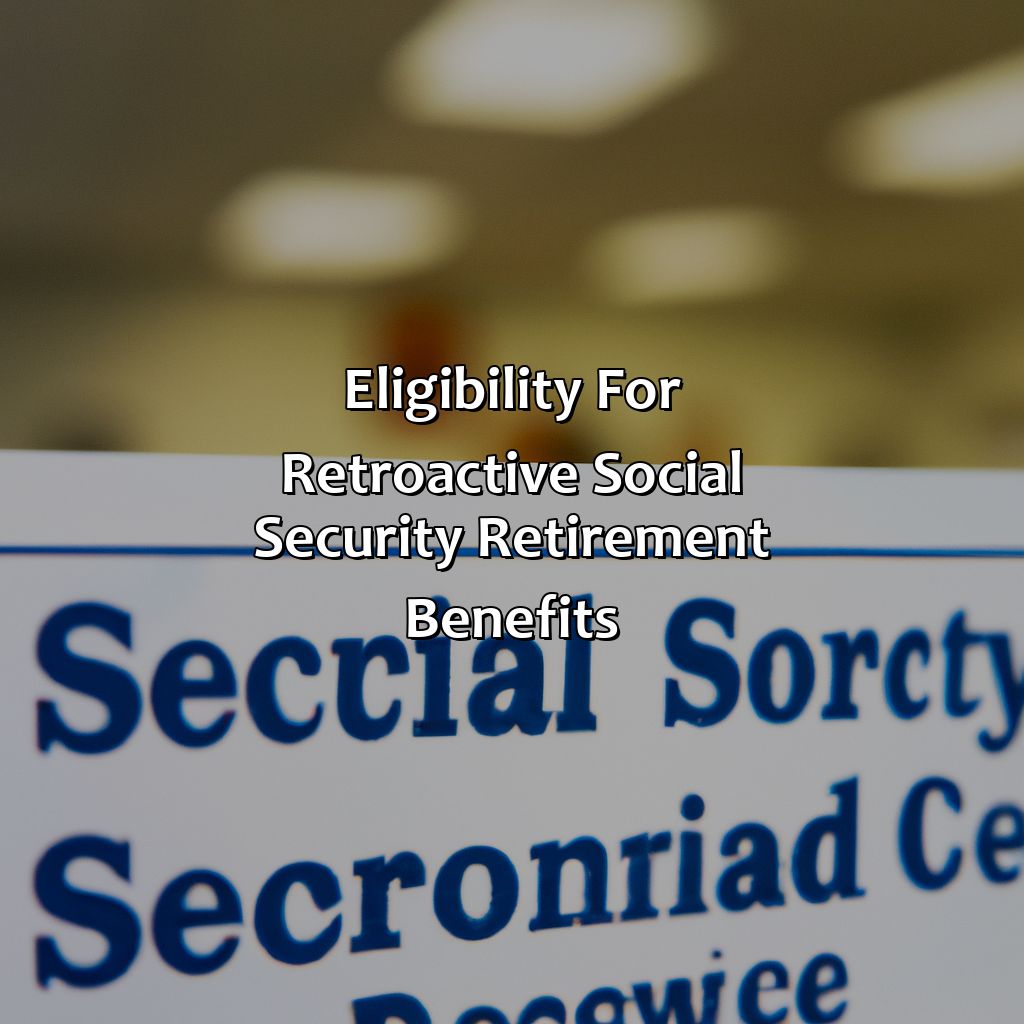How To Get Retroactive Social Security Retirement Benefits?
Key Takeaway:
- Eligibility for retroactive social security retirement benefits can be determined by considering factors such as age, work history, and disability or survivor benefits received. It is important to consult with a financial advisor to determine eligibility and the best course of action.
- Filing for retroactive social security retirement benefits involves completing an application process and meeting certain requirements, such as providing proof of age and work history. The timeline for receiving retroactive benefits can vary, depending on factors such as the date of eligibility and the application filing date.
- Factors that can affect retroactive social security retirement benefits include the determination of work history, as well as the impact of disability or survivor benefits on the amount of retroactive benefits received. Maximizing retroactive benefits can involve claiming delayed retirement credits and consulting with a financial advisor.
Are you wondering if you can get retroactively paid social security retirement benefits? This article will help you understand the process and eligibility requirements so that you may be able to receive the payments. You can get the guidance and support you need to start your journey towards a financially secure retirement.
Eligibility for Retroactive Social Security Retirement Benefits
Professional Guide to Qualify for Social Security Retirement Benefits Backdating
Receiving social security retirement benefits, retroactively is possible, but a stringent set of eligibility criteria must be met. Firstly, only those who have reached the age of 62 or older and have creditable earnings for at least ten years are eligible to apply. Additionally, one must have filed an application for retirement benefits to the Social Security Administration (SSA).
To be eligible, one must prove that their delay in filing was not intentional and that they could not have known about their eligibility. Furthermore, the request for retroactive benefits should be accompanied by a written statement that explains the circumstances of why the application was delayed.
It is important to note that the SSA provides a limited timeframe within which this application must be filed. Missed deadlines, even by a day, may result in an unalterable loss of benefits. Filing timely applications, gathering appropriate documentation, and seeking professional assistance is highly recommended.
Don’t miss out on the opportunity to access maximum social security earnings. Talk to a professional and file your application for retroactive benefits before it is too late.

Image credits: retiregenz.com by David Jones
Filing for Retroactive Social Security Retirement Benefits
It’s essential to file for retroactive Social Security retirement benefits with understanding of the application process and requirements.
In this section, we’ll look at the steps to take to qualify. Plus, the necessary documents to file your claim. We’ll also briefly look at the timeline for receiving retroactive benefits. This will help you get the most out of Social Security.

Image credits: retiregenz.com by David Jones
Application process and requirements
The process and prerequisites for acquiring retroactive social security retirement benefits are crucial. It is your responsibility to visit the local Social Security office, submit an application, understand the eligibility criteria based on age and work credits earned, submit evidence of ownership of bank accounts, investments or properties, and comply with the income limit guidelines.
If you’ve reached full retirement age (FRA), your benefits will start retroactively up to six months from the date your application was filed. If you’ve yet to achieve FRA, your payments will initiate up to six months back from the approval of your request. There are chances that the entire procedure may take a bit long as it involves gathering records to prove eligibility.
It is important to note that submitting an application at least three months before when you want payments to start is recommended as it can lessen complications.
A report by Investopedia states: “Not filing in a timely fashion can result in losing tens of thousands or even hundreds of thousands of dollars over time“. Missing out on retroactive benefits is like arriving fashionably late to a party that’s already over.
Timeline for retroactive benefits
You may be eligible to receive retroactive social security retirement benefits for up to six months prior to your application filing date. However, you must meet certain criteria to qualify for retroactive payments. These criteria include:
- being at least 62 years old,
- having enough credits in the social security system, and
- not currently receiving benefits.
To apply for retroactive benefits, you must fill out an application form and provide proof of your age and income. It is recommended that you apply as soon as possible after meeting the eligibility criteria because a delay could lead to a reduced payment.
If you are approved for retroactive benefits, keep in mind that the amount you receive will be reduced if you delayed filing beyond your full retirement age. Additionally, any payments that were made during the period between your eligibility and filing dates must be repaid.
Pro Tip: Contact a social security representative or seek professional advice before applying for retroactive benefits to ensure that all necessary documents are submitted and that all eligibility requirements are met.
Get ready to play the waiting game, because these factors can make or break your chances of scoring retroactive social security retirement benefits.
Factors Affecting Retroactive Social Security Retirement Benefits
To make sense of retroactive social security retirement benefits, you must contemplate the factors that influence their accessibility. This part of the article will talk about how work history determination, disability, and survivor benefits affect these benefits.

Image credits: retiregenz.com by David Woodhock
Work history determination
Determining Work History for Retroactive Social Security Retirement Benefits can be a complex process that requires various factors to be considered. Your work history plays a significant role in determining the amount of retroactive benefits you receive. The Social Security Administration looks at your earnings record, which includes years of employment and income amounts, to determine your eligibility for retroactive benefits.
The number of years you worked, as well as the amount of income you earned during those years, are vital factors in determining your retroactive benefits. The SSA considers your highest-earning years when calculating your average monthly earnings, which is used to determine your monthly benefit amount. It is essential to have accurate records of all tax returns and employment history to ensure that you receive the maximum retroactive benefits.
Additionally, other factors such as age and disability status also play a role in determining retroactive benefits. For example, if you have been disabled before retirement age or have dependents who are eligible for dependent benefits, this could affect the amount of retroactive benefits you receive.
A retiree named Mary was working with a healthcare non-profit organization until she turned 62 and decided to retire. After eight months of receiving retirement benefits payments from Social Security Administration (SSA), she found out that she had not received her complete entitlements. She had not applied for spousal derivative benefits since her spouse was not eligible for SSDI at age 62 due to his continued ability to work until age 66. This crucial information needed consideration while determining her eligibility for retirement benefit payments from SSA.
Disability and survivor benefits may impact your retirement plans, but at least you’ll have some peace of mind knowing your loved ones will be taken care of…hopefully.
Disability and survivor benefits impact
The eligibility for disability and survivor benefits may have an impact on retroactive social security retirement benefits. If you are eligible for these benefits, it may reduce the overall amount of retroactive social security retirement benefits. Additionally, if you receive disability or survivor benefits during the retroactive period, it may result in a reduction or elimination of any potential payments.
Furthermore, if you were denied disability or survivor benefits but later found eligible and were awarded back-payments, it may also reduce the retroactive social security retirement benefit payments.
However, if you wait to apply for disability or survivor benefits until after receiving your retroactive social security retirement benefit payments, it will not affect the amount you receive.
It is recommended that individuals who may be eligible for both types of benefits should carefully consider when to apply for each type of benefit to maximize their overall payment amounts. Additionally, seeking guidance from a financial advisor or professional can be helpful in understanding the full impact on overall finances and financial planning strategies.
Get ready to ‘Maximize’ your Social Security benefits and feel like a boss, even if you retired a long time ago!
Maximizing Retroactive Social Security Retirement Benefits
Maximize retroactive social security retirement benefits! Claim delayed retirement credits. This boosts the monthly benefit amount. Also, consult a financial advisor. They will help make smart decisions for maximising benefits.

Image credits: retiregenz.com by David Arnold
Claiming delayed retirement credits
Earning credits for delayed retirement is a crucial way to increase social security benefits. The longer the wait, the greater the benefit. The process includes filing an application, waiting for approval and claiming it within six months of approval.
To claim delayed retirement credits, one must complete the Social Security Retirement Benefit application. It is essential to indicate that they want to delay receiving retirement benefits when they apply online or by speaking with a Social Security representative. The maximum credit can be earned until age 70, at which point no additional credit is offered.
Claiming the maximum amount of credit depends on age and birth year. Those born after 1948 may earn credits worth up to 8% annually if they delay receiving retirement benefits beyond full retirement age. Once eligible for social security payments, the credits automatically start applying.
Adding spousal benefits into the mix can get complex as it involves spousal working records, marriage years, and spousal ages. Before taking any actions related to claims, it’s recommended to speak with a financial advisor who has deep knowledge in this area.
For example – Mr. Doe decided not to claim his Social Security Retirement Benefits at his full retirement age but rather wait for another five years. He gained delay credits worth over $10K annually at that time! Consulting with a financial advisor? Might as well consult a Magic 8 Ball, either way you’ll get vague answers and disappointment.
Consulting with a financial advisor
One way to optimize retroactive social security retirement benefits is seeking guidance from a financial expert. With expertise in retirement planning, they can assist in comprehending the convoluted rules and regulations. They analyze different scenarios and help in creating a strategy that maximizes benefits.
Financial advisors assess several pertinent factors such as age, expected income, and lifestyle expenses before recommending the best time to claim social security benefits. By coordinating with tax professionals, they assure minimal tax implications on higher income brackets for individuals receiving retroactive payments.
Circumstantial adjustments increase or decrease the final benefit amounts after retirement claim approval. Financial advisors have access to these critical details, as small distinctions result in significant changes over time. Hence consulting regularly with financial experts prevents loss of multiple months of possible social security payouts.
Recently, Joanne received a sizable payment of retroactive social security benefits amounting to over $50k owing to her delayed retirement filing. Being advised by a financial consultant helped in saving some portion of it which could have been lost without proper knowledge and preparation about taxation policies affecting their occupation’s future revenue streams.
Five Facts About How To Get Retroactive Social Security Retirement Benefits:
Retroactive Social Security retirement benefits can be paid out up to six months before you apply for benefits. (Source: Social Security Administration)
To be eligible for retroactive benefits, you must have turned your full retirement age when you filed for benefits. (Source: AARP)
Retroactive benefits can only be paid out for a maximum of six months. (Source: Social Security Administration)
If you were eligible for Social Security benefits before you applied, you may be able to receive retroactive benefits for up to six months. (Source: Investopedia)
It’s important to apply for Social Security benefits as soon as possible to avoid missing out on any potential retroactive benefits. (Source: AARP)
FAQs about How To Get Retroactive Social Security Retirement Benefits?
How can I get retroactive social security retirement benefits?
You can get retroactive social security retirement benefits by filing an application with the Social Security Administration (SSA). This must be done within six months of the date you want your benefits to start. You may be able to receive benefits for up to six months before the date you filed your application.
What is the eligibility criteria for retroactive social security retirement benefits?
To be eligible for retroactive social security retirement benefits, you must have reached your full retirement age and be entitled to receive benefits. You must also file your application within six months of the date you want your benefits to start.
What is the maximum amount of retroactive social security retirement benefits that I can receive?
The maximum amount of retroactive social security retirement benefits that you can receive is six months’ worth of benefits. This means that you may be able to receive up to six months of benefits before the date you filed your application.
Can I receive retroactive social security retirement benefits if I am already receiving benefits?
No, you cannot receive retroactive social security retirement benefits if you are already receiving benefits. Retroactive benefits are only available to individuals who have not yet filed their applications for benefits.
How long does it take to receive retroactive social security retirement benefits?
The time it takes to receive retroactive social security retirement benefits will depend on how quickly the SSA processes your application. Generally, it takes about four to six weeks to process an application for benefits.
What happens if my application for retroactive social security retirement benefits is denied?
If your application for retroactive social security retirement benefits is denied, you can appeal the decision. You must file an appeal within 60 days of receiving your denial letter. The appeal process may take several months.
 Checkout this IRS Loophole
Checkout this IRS Loophole 






